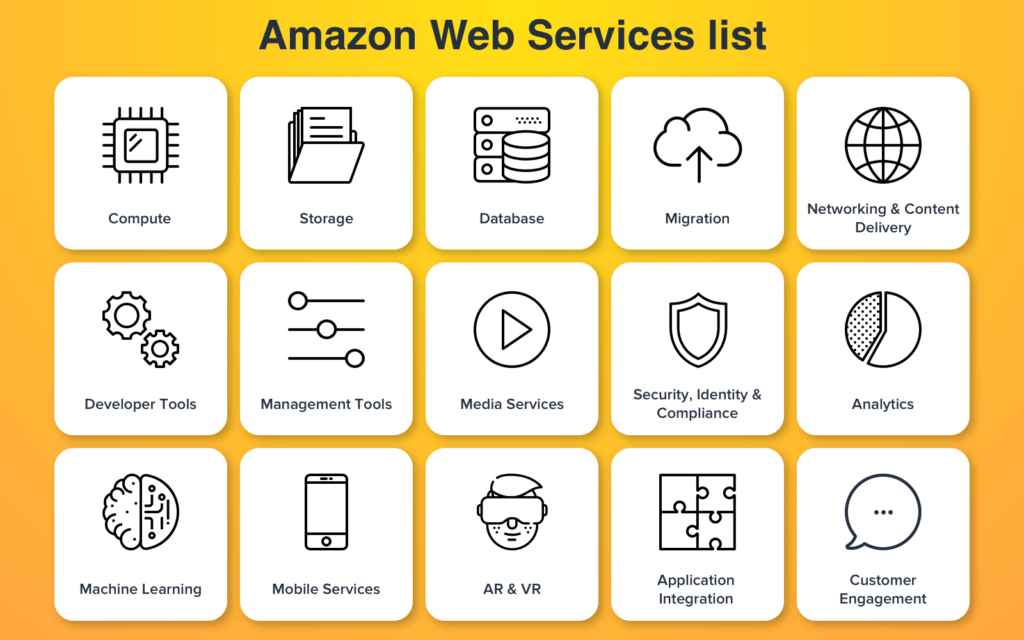Table of Contents
Introduction AWS
AWS (Amazon Web Services) is a comprehensive and widely adopted cloud computing platform that offers a range of services to help individuals and businesses meet their computing needs with unparalleled scalability, reliability, and flexibility. In this in-depth guide, we will delve into the types of AWS services and how they work, providing a comprehensive understanding of AWS and its capabilities. From computing and storage to databases, analytics, and beyond, AWS offers a vast array of services designed to empower organizations in their cloud journey.
Amazon Web Services

Amazon Web Services is a comprehensive cloud computing platform offered by Amazon. It provides a wide range of cloud services that include computing power, storage options, networking, databases, analytics, machine learning, and more. Amazon Web Services allows individuals and businesses to access on-demand computing resources and services over the internet, eliminating the need for physical infrastructure and providing scalability, reliability, and cost-effectiveness.
Amazon web services offers a global network of data centers spread across various regions worldwide. Users can select the specific regions and availability zones to deploy their applications and store their data. With Amazon Web Services, organizations can leverage a pay-as-you-go model, paying only for the resources and services they consume, which makes it highly flexible and cost-efficient.
The Amazon Web Services platform is designed to cater to various use cases and industries, from startups to enterprises. It provides a wide range of services, including virtual servers (EC2), storage (S3), databases (RDS, DynamoDB), networking (VPC), analytics (Athena, EMR), machine learning (SageMaker, Recognition), and many more. Amazon Web Services are built with a focus on scalability, security, and high availability, enabling businesses to scale their operations and meet the demands of their users effectively.
Overall, Amazon Web Services has transformed the IT industry by providing organizations with the tools and infrastructure needed to build, deploy, and manage applications and services in the cloud. It has become a leading cloud computing platform, powering a wide range of businesses and enabling innovation, agility, and cost savings in the digital era.
Types of AWS Services and How They Work:

- Computing Services: AWS provides a variety of computing services to meet different workload requirements. Amazon Elastic Compute Cloud (EC2) offers scalable virtual servers in the cloud, allowing users to easily deploy and manage their applications. EC2 instances can be tailored to specific computing needs, providing the necessary processing power, memory, and networking capabilities. Additionally, AWS Lambda enables serverless computing, allowing developers to run code without provisioning or managing servers, thereby reducing operational complexities.
- Storage and Content Delivery Services: AWS offers highly scalable and durable storage options. Amazon Simple Storage Service (S3) provides object storage for various types of data, including files, images, and videos. S3 ensures high availability and durability, making it ideal for backup, archival, and content distribution purposes. Amazon Elastic Block Store (EBS) provides persistent block-level storage volumes for use with EC2 instances, enabling data persistence and low-latency performance.
- Database Services: AWS offers a range of database services to meet different data management needs. Amazon Relational Database Service (RDS) provides managed relational databases, including popular options such as MySQL, PostgreSQL, and Oracle. For non-relational databases, Amazon DynamoDB offers a fully managed, highly scalable, and fast-performing NoSQL database solution. Additionally, AWS provides services like Amazon Redshift for data warehousing and Amazon Neptune for graph databases.
- Analytics and Machine Learning Services: AWS provides powerful services for data analytics and machine learning. Amazon Athena enables ad-hoc querying of data in S3 using SQL, while Amazon EMR offers a managed Hadoop framework for big data processing. With Amazon Kinesis, real-time streaming data can be ingested, processed, and analyzed. For machine learning, Amazon Web Services provides services such as Amazon Sage Maker, which simplifies the process of building, training, and deploying machine learning models, and Amazon Recognition, which enables image and video analysis.
- Networking Services: AWS offers a range of networking services to build and manage network infrastructure in the cloud. Amazon Virtual Private Cloud (VPC) allows users to create isolated virtual networks, providing control over IP addresses, subnets, and routing. AWS Direct Connect establishes a dedicated network connection between on-premises infrastructure and Amazon Web Services, ensuring secure and reliable data transfer. Additionally, Amazon Route 53 is a scalable domain name system (DNS) web service for routing incoming traffic to Amazon Web Services resources.
Conclusion:
Amazon Web Services offers a comprehensive suite of services that cater to diverse computing needs. From computing power and storage to databases, analytics, and networking, Amazon Web Services empowers organizations to leverage the cloud for enhanced scalability, reliability, and cost-effectiveness. By understanding the types of Amazon Web Services services and how they work, businesses can make informed decisions about which services best suit their requirements. AWS’s flexibility, scalability, and extensive functionality make it a leading choice for cloud computing, enabling organizations to drive innovation, improve efficiency, and achieve their desired outcomes.



